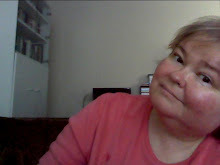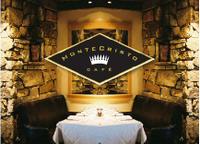 MonteCristo Cafe. Decided to try the new cafe on the block, near my office. Had a Cesar with chicken, pretty display but fairly unremarkable. I wouldn't intentionally go back a second time.
MonteCristo Cafe. Decided to try the new cafe on the block, near my office. Had a Cesar with chicken, pretty display but fairly unremarkable. I wouldn't intentionally go back a second time.
What was remarkable was my 90 minute deep tissue massage with Sara. That was my evening and then zzzland.
Wednesday, August 31, 2005
Posted by
Anna Haight
at
9:50 PM
0
comments
![]()
Tuesday, August 30, 2005
 Monday & Tuesday. I have to admit that I am writing this the Sunday of Labor Day weekend, as with posts that will follow this one above. Mostly I got caught up in editing and posting Katrina news on the ECTV site. Shocking. I might spend a whole post on it later. I was also surprised to find out how many friends and friends of friends are following my blog... heard that September was missing! So here I am.
Monday & Tuesday. I have to admit that I am writing this the Sunday of Labor Day weekend, as with posts that will follow this one above. Mostly I got caught up in editing and posting Katrina news on the ECTV site. Shocking. I might spend a whole post on it later. I was also surprised to find out how many friends and friends of friends are following my blog... heard that September was missing! So here I am.
So my 'cool' find of the day is the 'tasty soymilk and corn stew mix' by S&B that I picked up in Japantown earlier. It has English directions on back, so it's quite easy to make without a lot of my directions should any of you be interested. I made mine with wild coho salmon, purple potatoes, carrots, Italian sweet onion, and crisp niblets corn. I tend to make mine chunkier than the directions so it's more of a stew than chowder. This could probably be made from scratch, but the packaged sauce brick makes it really easy to make some delicious corn-chowder-like stew without fuss. The problem with being single, and cooking at home is some things don't downportion very well for one, and you end up eating the same thing for days... so this was dinner both Monday and Tuesday.
Posted by
Anna Haight
at
9:48 PM
0
comments
![]()
Sunday, August 28, 2005
 Let's see... Saturday was a woman's workshop in the morning, and creativity group in the afternoon. It got so creative, the last guest left at 11:30 p.m! Sunday I cleaned up after the party, cleaned up in general (wow - how exciting to blog ;P), visited my Dad and took him to a new place, The Ranch House, (a Mexican/Yucatan diner) for dinner. I brought along a gift that came in the mail from Kaoru last week, and he was SO delighted!
Let's see... Saturday was a woman's workshop in the morning, and creativity group in the afternoon. It got so creative, the last guest left at 11:30 p.m! Sunday I cleaned up after the party, cleaned up in general (wow - how exciting to blog ;P), visited my Dad and took him to a new place, The Ranch House, (a Mexican/Yucatan diner) for dinner. I brought along a gift that came in the mail from Kaoru last week, and he was SO delighted!
Posted by
Anna Haight
at
9:47 PM
0
comments
![]()
Friday, August 26, 2005
Two days. Thursday and Friday were pretty nose-to-the-grindstone days, but I did have Caren & Emil over for dinner on Friday night. It was fun to grill fresh wild salmon on the BBQ and serve it with Japanese-inspired dishes -- cucumber and pineapple infused tofu, unique mushroom mix rice, nimono winter squash/potatoes/carrots, and a big fruit salad w/chocolate filled cookies for dessert. Accompanied by our favorite Ridge Merlot. And some Arabic drum music!
Posted by
Anna Haight
at
11:09 PM
0
comments
![]()
Wednesday, August 24, 2005
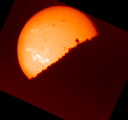 The sun. Hold on to your hats! NOAA Space Weather Advisory said today:
The sun. Hold on to your hats! NOAA Space Weather Advisory said today:
"Extreme geomagnetic storms could cause problems with power systems, spacecraft operations and other high and low frequency systems like satellite navigation and communications," said Bill Murtagh, a space weather forecaster at the NOAA Space Environment Center. Aviation groups have reported moderate to severe impacts to operations over the past two days due to degraded communications."
"Although NOAA predicted a major storm, this storm was unusually strong," added Murtagh. "The coupling between the solar wind interplanetary magnetic field and Earth's magnetic field was very strong. In fact, we've only observed this intense level of coupling a handful of times over the past 10 years."
Lots of flooding, earthquakes, and disturbances today! I note patterns as the Chief Editor of the Earthchanges TV Breaking News sections. There has been a huge spike in unusual earth/weather activity in the last couple days.
Posted by
Anna Haight
at
9:37 PM
0
comments
![]()
Tuesday, August 23, 2005
 Poke. My southern mother was crazy about "Poke weed"... she even talked her younger sister Nell into sending her some seeds when I was 7 or 8 years old. My mother eagerly planted them in the Pacific Northwest soil, and voila! Overnight the poke weed had grown into a tree sized shade 'tree' passing the roofline of our house along the way! Bear in mind that this green is supposed to be picked and eaten when the plant is a foot or less tall! No family in Kentucky had ever heard of one growing so high, and Mom's 'alien' plant created quite a stir in our little neighborhood. My mother tried to school me in the medicinal properties as this was one of the herbs in my great-grandmother's herbal arsenal. I found an article that sums up so well what my mother said, I'm going to copy it in whole here.
Poke. My southern mother was crazy about "Poke weed"... she even talked her younger sister Nell into sending her some seeds when I was 7 or 8 years old. My mother eagerly planted them in the Pacific Northwest soil, and voila! Overnight the poke weed had grown into a tree sized shade 'tree' passing the roofline of our house along the way! Bear in mind that this green is supposed to be picked and eaten when the plant is a foot or less tall! No family in Kentucky had ever heard of one growing so high, and Mom's 'alien' plant created quite a stir in our little neighborhood. My mother tried to school me in the medicinal properties as this was one of the herbs in my great-grandmother's herbal arsenal. I found an article that sums up so well what my mother said, I'm going to copy it in whole here.
Poke-ing around in the garden 
by Corinna Wood
[Editor's note: Pokeweed is a potentially toxic plant; taken in large doses, it can cause severe side effects, including nausea, vomiting and diarrhea. Try these recipes at your own risk.]
Growing up in the Northeast, I loved playing with the purple pokeberries, painting designs on my skin. My parents allowed this, though they made it clear that I shouldn't eat the berries of this "poisonous, invasive weed." The huge poke plants were such a bane in their garden that they would actually tie a rope around the roots and use a Jeep to pull them out!
So when I moved to the South, I was surprised to hear a number of people report that their grandmothers always ate poke as a spring green. Intrigued, I discovered that poke root has traditionally been used in tiny doses as an immune stimulant. And swallowing one berry a day is an old treatment for arthritis. This powerful plant actually has a wide range of medicinal uses – but you have to treat it with respect or risk unpleasant side effects (see below).
As it turns out, there's a long history here in the mountains of using this common "weed" as a potherb. But don't make the all-too-common mistake of confusing "poke sallit" (the English word for cooked greens) with "poke salad." DON'T EAT POKE IN A SALAD! It's considered safe ONLY when boiled in three changes of water (traditionally with some pork or "fatback"). And it should be harvested for cooking greens ONLY when the plant is less than a foot tall.
I've cooked poke this way a few times. It was certainly tasty (especially with the fatback!), but I was still a bit mystified. Why all the focus on poke? This is a time of year when many wild greens are abundant – dandelion, chickweed and nettles are among my favorites. And with these, you don't need to toss out the cooking water (and a lot of nutrients with it). But I do know folks who say they feel a powerful energy from eating the poke greens.
My favorite way to use poke is to make a tincture from the root for stimulating the immune system. Herbs can rival the effectiveness of antibiotics, and they're generally much gentler on the body. Many herbalists turn to goldenseal for this purpose, but it's an endangered species. Poke, on the other hand, is a weed – the problem is not having too little of it, but too much. And for most purposes, poke is at least as good, if not better.
Pokeroot is best dug up in the fall, after the plant has died back for the winter. This is when the plant is the most medicinal and the least toxic. The next best time to dig the roots is in the early spring, when the leaves are just coming out (as long as you're sure what you're picking!).
As anyone who's ever tried to pull up a poke plant knows, getting anything but the smallest roots out of the ground is a project. They range in size from a large carrot to a construction cone. Fortunately, just one small root will make enough medicine to last you and your loved ones for years – proving once again that there's no lack of good medicine all around us.
Once you've dug up the root (and parked the Jeep), the next step – if you've decided to give pokeweed a try – is drawing out those medicinal properties. The best way to do that is to make a tincture (alcohol extract). Wash the root, chop it into small pieces, fill a jar with the plant material, and then add enough 100-proof alcohol to cover the roots. Leave it on your counter for six weeks, then strain out the roots. The resulting milky liquid is remarkably mild-looking and -tasting, considering the punch it packs.
Poke is so powerful that it's taken by the drop. Begin with one to three drops (using a dropper, of course). Wait 24 hours. If that doesn't seem to help, add one drop per day to the dosage (and that's drops, not droppersful!).
Individuals show widely varying tolerance for poke. Some people can't handle more than three or five drops per day, while others can take 25 or 50 drops with no adverse effects. The side effects of poke include mental unclarity, spaciness and out-of-body feelings. If you notice such feelings, it means you've found your tolerance level, so back off to a lower dosage. If you take way too much (such as mistaking droppersful for drops, which some people have done!), you may encounter more severe side effects, such as nausea, vomiting and diarrhea.
When I was using poke to treat Lyme disease a number of years ago, I found that after taking 10 drops per day for several weeks, I started feeling unclear, spacy and disconnected, as if I weren't really in my body. I cut the dosage back to five drops and the side effects vanished, but the tincture was still very effective in helping resolve the Lyme disease. Remember, everyone's tolerance and needs are different.
Over the years, I've found poke to be invaluable as an herbal alternative to antibiotics when immune or lymphatic stimulation is needed. For many generations, this plant has helped people with immune issues ranging from sore throat to breast cancer. And of course, there are times when antibiotics are called for – so when in doubt, consult your doctor or herbalist.
In my community, poke tincture is a favorite for sore throats, strep throat, severe colds and respiratory infections. It's also used for infected gums, swollen lymph glands and breast cysts. Studies in Germany and the United States are even finding positive results with HIV, cancer and lymphoma. In addition, it's very effective in treating genital herpes – taking just a few drops when the tingling begins usually prevents the blister phase entirely and reduces the frequency of outbreaks.
Poke root can also be made into an oil simply by substituting oil for alcohol. Any cooking oil will work, but olive oil is my favorite because of its high resistance to rancidity. And by melting in some beeswax (which gives it a creamy consistency), the oil can be made into a balm or salve. Both the salve and the oil are also used externally to dissolve lumps, bumps, growths and tumors. And many people find them helpful when applied externally to swollen lymph glands, sore throats or breast lumps.
Pokeberries are useful, too – and not just for body paint. (This paint, by the way, is quite safe; it's only the seeds inside that are toxic, and then only when chewed.) In Appalachian folk medicine, the berries are swallowed as a treatment for arthritis and for immune stimulation – one berry (either fresh or dried) is the equivalent of one drop of root tincture.
Since the seeds are the toxic part, you just spit them out. And even if you swallow some seeds, don't worry – they're extremely difficult to break open with your teeth and will come out the other end intact. (That's how poke spreads, in fact – birds love to eat the berries, and then the seeds spread through their droppings.) Although poke proliferates by seed, the plants are perennial, and the roots will grow larger every year.
So if you find yourself cursing this "dangerous, noxious weed" in your yard or garden this spring, just remember that if you let a few plants thrive until fall, they can reward you with some very powerful medicine – not to mention beautiful purple berries that make a delightful body paint!
[Corinna Wood, the director of Red Moon Herbs, has been teaching herbal medicine for more than 10 years. She can be reached at 669-1310 or via her Web site (redmoonherbs.com).]
Posted by
Anna Haight
at
10:49 PM
0
comments
![]()
Monday, August 22, 2005
Focus. This morning I went to a "Focus" seminar with Jo-Ann and we enjoyed lunch at Paradise Vegetarian in San Rafael, an place Jo-Ann has had her eye on for awhile. Nice buffet with fresh food. Meat items as well.
Then I drove off into the sun to take Dad for his hearing aid check/adjustment and enjoyed catching up with his activities. We got some flour on the way home so he could make cake for the 'sing-along' activity tonight. I then continued on to pick up some of my favorite olive oil at The Olive Press, and meet Linda for dinner. We enjoyed lasagne at Cafe Citti, a consistently good place both on all counts, food, service and ambiance. Chatted with Michael on the way home to catch him up on the creative loop since Saturday night, and now am logging the day!
Posted by
Anna Haight
at
9:29 PM
0
comments
![]()
Sunday, August 21, 2005
Creativity rules! I so enjoyed prepping for my friends arrival on Saturday, and the event was great! The creative juices were flowing and the possibility for bringing our dreams into material form was physically palpable. People left in shifts, there was a desire to continue our creativity salon, the last person leaving at 11:30 p.m. (the event was designed for 4-6 p.m.). There was a strong desire to keep the momentum going, so we're meeting every week! Whee!
Sunday I did clean up and catch up on household chores. Visited a new restaurant for lunch, the Bombay Garden. Quite nice Indian style buffet in San Rafael. Cheerful staff, very pleasant surroundings and good, although on the spicy side food. Warm yellow and magenta interior with intricately inlaid wooden chairs.
Posted by
Anna Haight
at
10:01 PM
0
comments
![]()
Labels: Indian
Friday, August 19, 2005
 E & O Trading Company. Helen and I met at the E&O Trading Company for dinner. It was nice to catch up with her. Her description of the marketing world was fascinating.
E & O Trading Company. Helen and I met at the E&O Trading Company for dinner. It was nice to catch up with her. Her description of the marketing world was fascinating.
Home and more prep for tomorrow! Another guest popped up, friend Michele is visitng from Yuba City.
Tomorrow should be busy!
Posted by
Anna Haight
at
10:48 PM
0
comments
![]()
Thursday, August 18, 2005
Wednesday, Thursday. Well, work comes to mind, but I did enjoy getting together with Paul, Julianne and Jaison & friends on Wednesday evening. Thursday evening I prepped for my Saturday creativity group.... no notable restaurants -- called Anna's leftovers for mid-week.
Posted by
Anna Haight
at
11:08 PM
0
comments
![]()
Tuesday, August 16, 2005
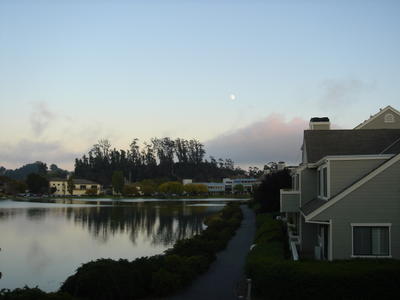
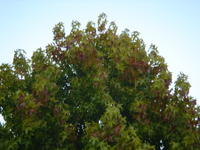 I Spy! the first sign of fall! I looked outside from my living room this evening, and what did I see? Turning leaves! Had to snap a quick pic - left. See that? Where did our summer go!
I Spy! the first sign of fall! I looked outside from my living room this evening, and what did I see? Turning leaves! Had to snap a quick pic - left. See that? Where did our summer go!
Inspired by my favorite time of night, when the colors become vivid in the light, I snapped this one -above right - from my deck looking down the shoreline path. I should insert a photo of me walking on it :-).
I enjoyed talking with my Uncle Pat in Nebraska using my Skype phone this evening. Now THAT's a cool find. Talk all you want with others so connected by internet, all over the world for free! I've had it a few months now and it's great. He reminded my my twin Aunts - Nancy & Betty - have a birthday on the 18th! Gotta call them...
Posted by
Anna Haight
at
7:45 PM
0
comments
![]()
Monday, August 15, 2005
 Starting the dance of another week. Nothing remarkable about the workday. On the way home, however, I called Jo-Ann and invited her family over to dinner & swimming. In one hour from shopping to table, managed the following menu: Lemon & herb steamed shrimp in shell; dungeness crab w/melted butter and/or garlic-ponzu; baby organic lettuces-sunflower sprouts and spiced pecan salad with choice of cranberry orange dressing, traditional French vinegarette, or olive oil and balsamic vinegar; sun-ripened heirloom red and yellow tomatoes with fresh baby mozerella and fresh organic basil; rustic roasted garlic French bread; and for dessert, fresh farmer's market raspberries made into a kind of upside down cake -- gluten free! All accompanied by Gewürztraminer white for the adults, and organic pear juice for the kids. Six of us having fun... afterwards, even though rather late and cold, Jonathon took the kids into my pool!
Starting the dance of another week. Nothing remarkable about the workday. On the way home, however, I called Jo-Ann and invited her family over to dinner & swimming. In one hour from shopping to table, managed the following menu: Lemon & herb steamed shrimp in shell; dungeness crab w/melted butter and/or garlic-ponzu; baby organic lettuces-sunflower sprouts and spiced pecan salad with choice of cranberry orange dressing, traditional French vinegarette, or olive oil and balsamic vinegar; sun-ripened heirloom red and yellow tomatoes with fresh baby mozerella and fresh organic basil; rustic roasted garlic French bread; and for dessert, fresh farmer's market raspberries made into a kind of upside down cake -- gluten free! All accompanied by Gewürztraminer white for the adults, and organic pear juice for the kids. Six of us having fun... afterwards, even though rather late and cold, Jonathon took the kids into my pool!
Posted by
Anna Haight
at
10:46 PM
0
comments
![]()
Sunday, August 14, 2005
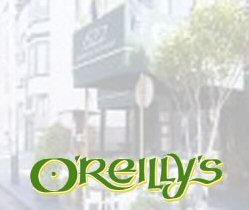 OReilly's. After a long sleep, Jo-Ann and I went to North Beach and tried a "Celitic Brunch" at an awesome Irish place. It has to be authenitic when the chef has a distinct Irish accent, and a waitress too! I had the Gammon (Canadian bacon-like Irish sweet cured ham) with poached eggs over Irish potato pancake. It came with some chopped cabbage on the side, and this freshly baked brown bread on the side that tasted very much like one of my Mom's recipes. Jo-Ann had the same thing but with Irish Smoked Salmon Boxty. The waiter thought I was Irish, when finding out that although my heritage did not include any Irish, but that it included a good dose of Norwegian, started chatting away in that language! Apparently he'd spent a couple years living there and picked up the Norse language. Fabulous place, and what atmosphere! Definitely a place to return.
OReilly's. After a long sleep, Jo-Ann and I went to North Beach and tried a "Celitic Brunch" at an awesome Irish place. It has to be authenitic when the chef has a distinct Irish accent, and a waitress too! I had the Gammon (Canadian bacon-like Irish sweet cured ham) with poached eggs over Irish potato pancake. It came with some chopped cabbage on the side, and this freshly baked brown bread on the side that tasted very much like one of my Mom's recipes. Jo-Ann had the same thing but with Irish Smoked Salmon Boxty. The waiter thought I was Irish, when finding out that although my heritage did not include any Irish, but that it included a good dose of Norwegian, started chatting away in that language! Apparently he'd spent a couple years living there and picked up the Norse language. Fabulous place, and what atmosphere! Definitely a place to return.
We walked along Columbus Avenue enjoying the Sunday morning atmosphere, hearing old men smoking at tables speak Italian. I introduced Jo-Ann to the City Lights Bookstore, and then we went to Black Oak books across the street.
It was very foggy and chilly, so we headed off to San Jose to enjoy Santana Row, since Jo-Ann hadn't been there either. It was beautiful weather, and the right choice. We were inspired by all the creativity in the shops, but were not impressed by the pillow at Tommy Bahama's on sale for $59, reduced from $225, nothing exceptional! Provided fuel for discussion about relative values though. Found out the 1-bedroom 700sq ft condos were selling for just short of $500K...
Jonathon was cooking some fabulous Copper River Salmon as Jo-Ann and I headed back to their home for the end of 'girls' time, and we enjoyed a wonderful dinner and conversation over some delish Ridge red. And, Jo-Ann's mother is going to be just fine, needs some observation time for a couple days though.
Now I'm home, blogging away! Savored this weekend!
Posted by
Anna Haight
at
10:44 PM
0
comments
![]()
Labels: Irish, San Francisco
Saturday, August 13, 2005
 Gravenstein Apple Fair. Today was packed with activities! First, after staying up quite late, I leapt out of bed to go for an early hair appointment. Followed immediately by picking up some things that my Dad needed, and going to his place. He was enthused about the idea of meeting our friend, Daniel, for a couple hours at the Gravenstein Apple Fair in Sebastopol. So we headed off there, stopping at our favorite Cafe Citti on the way. He enjoyed his first 'raw' food since he began treatment, one of their fresh crisp salads.
Gravenstein Apple Fair. Today was packed with activities! First, after staying up quite late, I leapt out of bed to go for an early hair appointment. Followed immediately by picking up some things that my Dad needed, and going to his place. He was enthused about the idea of meeting our friend, Daniel, for a couple hours at the Gravenstein Apple Fair in Sebastopol. So we headed off there, stopping at our favorite Cafe Citti on the way. He enjoyed his first 'raw' food since he began treatment, one of their fresh crisp salads.
We enjoyed the fair, music and chatting with people. Daniel, the reigning juggling champion, did not repeat the feat, although he got wild applause again. I bought some East/West ceramic goblets from someone who I found lived only 5 blocks away from me on Capitol Hill in Seattle. I love happy coincidences.
I ran Dad back home then on to pick up Jo-Ann for 'girl's weekend' out. There was quite the flurry of activity, an emergency ambulance ride to the hospital for her Mom just a few minutes before I arrived, but everyone thought it was a good idea for us to continue our plans. We had planned to go to La Tabla, but found it was closed on Saturday nights (go figure), so we tried another new place, Pacific Cafe instead. It is a seafood restaurant across from the College of Marin in Kentfield, and it was really good. We'll go back again.
Posted by
Anna Haight
at
9:46 PM
0
comments
![]()
Friday, August 12, 2005
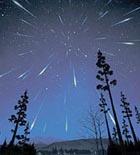 Perseids. I made dinner (chicken lasagne, organic baby greens with spiced pecans salad, and fresh organic strawberry shortcake) for a friend and we waited for the annual Perseid show in the sky from midnight to 3 a.m. west coast time. My house usually has a dark and clear enough sky to enjoy these from my deck. Realizing there was a lot of time between dinner and nature's skyshow, we went to see Junebug.
Perseids. I made dinner (chicken lasagne, organic baby greens with spiced pecans salad, and fresh organic strawberry shortcake) for a friend and we waited for the annual Perseid show in the sky from midnight to 3 a.m. west coast time. My house usually has a dark and clear enough sky to enjoy these from my deck. Realizing there was a lot of time between dinner and nature's skyshow, we went to see Junebug.
The sky was partly obscured by clouds, but sitting in my swiveling deck chairs with pillows and blankets, we could still enjoy a few streaking across the sky. Didn't look like the picture here, but a one-by-one effect.
Posted by
Anna Haight
at
11:59 PM
0
comments
![]()
Thursday, August 11, 2005
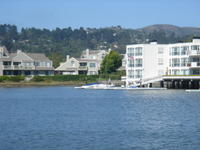 Life as Usual. Two day post again... besides busy days at work, I enjoyed a new restaurant "Christopher's Cafe" in Novato on my way yesterday evening to visit with friends including Jaison. Christoper's Cafe billed itself as having home cooked meals, and they did do a very nice job with the food, and were prompt and friendly. My trip to Japan planned for September cancelled as suddenly as it showed up on the schedule. Oh well.
Life as Usual. Two day post again... besides busy days at work, I enjoyed a new restaurant "Christopher's Cafe" in Novato on my way yesterday evening to visit with friends including Jaison. Christoper's Cafe billed itself as having home cooked meals, and they did do a very nice job with the food, and were prompt and friendly. My trip to Japan planned for September cancelled as suddenly as it showed up on the schedule. Oh well.
Today I missed seeing a friend for dinner, but I went up to the San Rafael farmers market and enjoyed a lovely walk through the various stalls with enticing wares. I sucumbed to some organic stawberries and raspberries... ended up having a quick dinner at Akira's where Takeshi make me some off-menu specials such as hosokiri and a veggie crunchy salmon skin roll.
Now that my outside house painting is complete, took a photo a few days ago of its freshly painted look with my zoom lens across the water from it. Thought the blog was ready for another photo, and not having one of Chrisopher's, this was my answer for today.
Posted by
Anna Haight
at
11:05 PM
0
comments
![]()
Tuesday, August 09, 2005
Work, work, work. That was today's adventure. Busy from the early start to late finish at the office. Got home checked in with Dad, did some paperwork for him, chatted with friends, and now, I'm blogging. I made myself a pizza from scratch, have leftovers for tomorrow. Wheee!
Posted by
Anna Haight
at
11:00 PM
0
comments
![]()
Monday, August 08, 2005
 Back to Normal. My first normal day at work! Was nice to feel back in my routine again. I was pleasantly surprised to notice that I received an acknowledgment in my friend's newly published book, "Solar Rain". I also made a new connection in Marin in the nuclear abolition movement through my efforts to connect my friend Haruko to Dr. Caldicott. Her policy non-profit NPRI (Nuclear Policy Research Institute) has a board member residing in West Marin, and he, in the blink of an eye, sent me out a CD "Nuclear Deception" which I'll be watching soon. I just have to be in a certain mood to see those kind of things as they are too heartbreaking otherwise. The other surprise of the day was finding out I'll be going to Japan on a business trip towards the end of September to meet about global training initiatives for my company. I decided to pay my friends at Akira a visit for dinner this evening, and have been editing the ECTV site and catching up with friends on the phone otherwise.
Back to Normal. My first normal day at work! Was nice to feel back in my routine again. I was pleasantly surprised to notice that I received an acknowledgment in my friend's newly published book, "Solar Rain". I also made a new connection in Marin in the nuclear abolition movement through my efforts to connect my friend Haruko to Dr. Caldicott. Her policy non-profit NPRI (Nuclear Policy Research Institute) has a board member residing in West Marin, and he, in the blink of an eye, sent me out a CD "Nuclear Deception" which I'll be watching soon. I just have to be in a certain mood to see those kind of things as they are too heartbreaking otherwise. The other surprise of the day was finding out I'll be going to Japan on a business trip towards the end of September to meet about global training initiatives for my company. I decided to pay my friends at Akira a visit for dinner this evening, and have been editing the ECTV site and catching up with friends on the phone otherwise.
Posted by
Anna Haight
at
9:55 PM
0
comments
![]()
Sunday, August 07, 2005
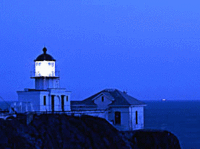 A Day to Myself. Thinking I could sleep in, I turned off the alarm function on my clock. Never mind. There was dense fog this morning, and I was awakened by the low bellow of the fog horns at sometime a bit after 5 a.m. Pt. Bonita lighthouse near the Golden Gate is the culprit. I looked out my window, and although the bay in front of my house was perfectly clear, you could see thick billowy clouds of fog all over the skyline touching the hilltops towards the open bay.
A Day to Myself. Thinking I could sleep in, I turned off the alarm function on my clock. Never mind. There was dense fog this morning, and I was awakened by the low bellow of the fog horns at sometime a bit after 5 a.m. Pt. Bonita lighthouse near the Golden Gate is the culprit. I looked out my window, and although the bay in front of my house was perfectly clear, you could see thick billowy clouds of fog all over the skyline touching the hilltops towards the open bay.
I did LOTS of laundry and straightened things up thinking of the active things some of my friends had mentioned doing today, like kayaking around Angel Island, or doing the Chicago half-marathon. I got very tired of knocking around the walls of the house by myself by about 1 p.m. and called Linda. She suggested a movie that she thought would be right up my alley - Fear and Trembling - a Japanese and French film with English subtitles about a Belgian woman's experience of corporate Japan.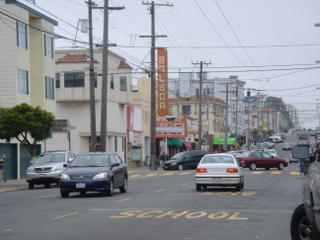 It was playing at the Balboa, in the Richmond district, according to my car, just 14 minutes away. So I decided to have lunch somewhere in the Richmond and take in the film.
It was playing at the Balboa, in the Richmond district, according to my car, just 14 minutes away. So I decided to have lunch somewhere in the Richmond and take in the film. 
The Superior Palace advertised "Grand Opening" proudly on a red banner under its green canopy, so I decided to give it a try. It was superior considering a lovely prawn and tender greens rice plate was priced at $3.50, and simply delicious. It was packed with, apparently, Chinese, no caucasians in sight and no English was heard around me.
Fear and Trembling was quite hysterical and quite recommendable.
I came back over the bridge and decided to go to Whole Foods to pick up something to cook this evening, but the parking situation was hopeless, so I took it as a sign that I need to go out... I did then stop at Sloat Garden Center and picked up a pot of beautiful Melissa for my front doorstep.
Posted by
Anna Haight
at
5:57 PM
0
comments
![]()
Labels: Chinese, San Francisco
 Uva Trattoria & Bar. Last evening, after dropping Dad off, I connected with Linda who previously had suggested dinner in Napa since she was without Olivia and I ready to have a little celebration too. Discussing the several good places we could go, we decided on Uva since Yalda had mentioned one of Linda's former students was now managing it. Her student at St. Francis his 7 & 8th grade years, he's now the Maitre d'Harmonica at Uva, and has his own radio show. A very artistic man. We neither had been to Uva before, and it was the perfect pick. Joe is a very gregarious host to all in the restaurant, no wonder it was packed by 7! We enjoyed his suggestion, the Rib-eye beef with green peppercorns in white wine reduction. We enjoyed it, and have definitely met our meat quota for awhile with the generous serving. He introduced us to a new drink, Limoncello - wow. Served in a shot glass it was a mix of fresh lemon and rind with sugar water which had been steeped in Everclear for 3 days. I shocked Linda by copying Joe's one-gulp style. Luckily, it was not necessary to stand up for awhile, that one packs a punch! Linda said I turned red in the face soon thereafter. Well, I'm not used to drinking much beyond an occasional single glass of chardonnay with dinner, so I'm not surprised my body registered it's surprise.
Uva Trattoria & Bar. Last evening, after dropping Dad off, I connected with Linda who previously had suggested dinner in Napa since she was without Olivia and I ready to have a little celebration too. Discussing the several good places we could go, we decided on Uva since Yalda had mentioned one of Linda's former students was now managing it. Her student at St. Francis his 7 & 8th grade years, he's now the Maitre d'Harmonica at Uva, and has his own radio show. A very artistic man. We neither had been to Uva before, and it was the perfect pick. Joe is a very gregarious host to all in the restaurant, no wonder it was packed by 7! We enjoyed his suggestion, the Rib-eye beef with green peppercorns in white wine reduction. We enjoyed it, and have definitely met our meat quota for awhile with the generous serving. He introduced us to a new drink, Limoncello - wow. Served in a shot glass it was a mix of fresh lemon and rind with sugar water which had been steeped in Everclear for 3 days. I shocked Linda by copying Joe's one-gulp style. Luckily, it was not necessary to stand up for awhile, that one packs a punch! Linda said I turned red in the face soon thereafter. Well, I'm not used to drinking much beyond an occasional single glass of chardonnay with dinner, so I'm not surprised my body registered it's surprise.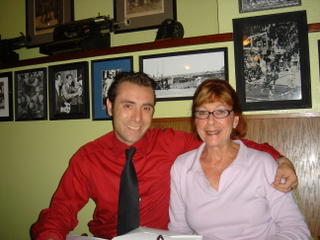
Smokin' Joe Herrschaft. Linda's student is quite a versatile talent. He plays harmonica in a band, does voice-overs and has his own Radio Show on KSVY 98.3 FM "Wakin'Up w/the Blues". If you are not in the broadcast area, it can be picked up streaming off the net at the KSVY website.
He did a little Sicilian impression for us, it was great. Doesn't hurt that he's 1/4 Sicilian. I snapped a photo of the reunion at the right.
He invited us to stay for the jazz from 9:00 and we wished we could, but Miss Olivia was joining us at 7:45 and so any lingering in the bar was out.
Posted by
Anna Haight
at
9:44 AM
0
comments
![]()
 Father's move home. The day came at last, for Dad to move back to his place. The packing took longer than anticipated, since we visited his place nearly every weekend and he'd bring back something. After filling the trunk quite full, we were on our way back to his place in Sonoma. Although we made the stay as much fun as we could, it was good to have our very own space back again. And Dad was very eager to be with his lady friends again. I helped him pick out yet more chocolates for the giving. Dad moved in the weekend before Memorial Day in May, so it's nearly 3 months.
Father's move home. The day came at last, for Dad to move back to his place. The packing took longer than anticipated, since we visited his place nearly every weekend and he'd bring back something. After filling the trunk quite full, we were on our way back to his place in Sonoma. Although we made the stay as much fun as we could, it was good to have our very own space back again. And Dad was very eager to be with his lady friends again. I helped him pick out yet more chocolates for the giving. Dad moved in the weekend before Memorial Day in May, so it's nearly 3 months.
Moves are not without their glitches. After I celebrated with Linda (above), I called to see how Dad was. He couldn't get his shaver to go live with the electricity and asked me to come back and help him. Luckily I called him only a few blocks from his house, so I turned around and made it to his place in 5 minutes. The trouble was the circuit breaking type plug-in in his bathroom, so voila! I pushed the red button, and Dad's Braun Synchro was back on-line.
Posted by
Anna Haight
at
8:45 AM
0
comments
![]()
 Judy's Breadsticks. Made Dad an open faced toasted sandwich with this great bread yesterday.
Judy's Breadsticks. Made Dad an open faced toasted sandwich with this great bread yesterday.
Very healthy ingredients and nice flavor.
Posted by
Anna Haight
at
8:17 AM
0
comments
![]()
Saturday, August 06, 2005
Nuclear Bombs Aren't Cool.
Most of my friends know that I was an exchange student in Hiroshima as a junior in high school. My host parents and extended family there were survivors of the nuclear holocaust of August 6, 1945. My grandmother with her lilting Hiroshima-ben (dialect) told me in detail the most vivid pictures of her experience as a young nurse searching for her family members after the bomb struck. Living there and having the opportunity to keep hearing and taking in all the stories of friends, family exhibits, the Peace Park without my knowing at the time dramatically shifted my worldview. I've managed to collect a lot of books, videos and other materials - not as my life's work, but as a human deeply touched by the searing tragedy of one decision that cut a path of change through generations and inspired people I know to put the issue to the front of their lives. This is the 60th anniversary, and although my blog is really themed for looking for the 'cool' and new, something very uncool has its place in remembrance here too.
A dear friend just sent me a link to the Truthout site's collection of pieces today, which I post here.
No more Hiroshimas please.
T R U T H O U T
http://www.truthout.org/docs_2005/080505E.shtml
The Myths of Hiroshima
By Kai Bird and Martin J. Sherwin
The Los Angeles Times
Friday 05 August 2005
Sixty years ago tomorrow, an atomic bomb was dropped without warning on the center of the Japanese city of Hiroshima. One hundred and forty thousand people were killed, more than 95% of them women and children and other noncombatants. At least half of the victims died of radiation poisoning over the next few months. Three days after Hiroshima was obliterated, the city of Nagasaki suffered a similar fate.
The magnitude of death was enormous, but on Aug. 14, 1945 - just five days after the Nagasaki bombing - Radio Tokyo announced that the Japanese emperor had accepted the US terms for surrender. To many Americans at the time, and still for many today, it seemed clear that the bomb had ended the war, even "saving" a million lives that might have been lost if the US had been required to invade mainland Japan.
This powerful narrative took root quickly and is now deeply embedded in our historical sense of who we are as a nation. A decade ago, on the 50th anniversary, this narrative was reinforced in an exhibit at the Smithsonian Institution on the Enola Gay, the plane that dropped the first bomb. The exhibit, which had been the subject of a bruising political battle, presented nearly 4 million Americans with an officially sanctioned view of the atomic bombings that again portrayed them as a necessary act in a just war.
But although patriotically correct, the exhibit and the narrative on which it was based were historically inaccurate. For one thing, the Smithsonian downplayed the casualties, saying only that the bombs "caused many tens of thousands of deaths" and that Hiroshima was "a definite military target."
Americans were also told that use of the bombs "led to the immediate surrender of Japan and made unnecessary the planned invasion of the Japanese home islands." But it's not that straightforward. As Tsuyoshi Hasegawa has shown definitively in his new book, "Racing the Enemy" - and many other historians have long argued - it was the Soviet Union's entry into the Pacific war on Aug. 8, two days after the Hiroshima bombing, that provided the final "shock" that led to Japan's capitulation.
The Enola Gay exhibit also repeated such outright lies as the assertion that "special leaflets were dropped on Japanese cities" warning civilians to evacuate. The fact is that atomic bomb warning leaflets were dropped on Japanese cities, but only after Hiroshima and Nagasaki had been destroyed.
The hard truth is that the atomic bombings were unnecessary. A million lives were not saved. Indeed, McGeorge Bundy, the man who first popularized this figure, later confessed that he had pulled it out of thin air in order to justify the bombings in a 1947 Harper's magazine essay he had ghostwritten for Secretary of War Henry L. Stimson.
The bomb was dropped, as J. Robert Oppenheimer, scientific director of the Manhattan Project, said in November 1945, on "an essentially defeated enemy." President Truman and his closest advisor, Secretary of State James Byrnes, quite plainly used it primarily to prevent the Soviets from sharing in the occupation of Japan. And they used it on Aug. 6 even though they had agreed among themselves as they returned home from the Potsdam Conference on Aug. 3 that the Japanese were looking for peace.
These unpleasant historical facts were censored from the 1995 Smithsonian exhibit, an action that should trouble every American. When a government substitutes an officially sanctioned view for publicly debated history, democracy is diminished.
Today, in the post-9/11 era, it is critically important that the US face the truth about the atomic bomb. For one thing, the myths surrounding Hiroshima have made it possible for our defense establishment to argue that atomic bombs are legitimate weapons that belong in a democracy's arsenal. But if, as Oppenheimer said, "they are weapons of aggression, of surprise and of terror," how can a democracy rely on such weapons?
Oppenheimer understood very soon after Hiroshima that these weapons would ultimately threaten our very survival.
Presciently, he even warned us against what is now our worst national nightmare - and Osama bin Laden's frequently voiced dream - an atomic suitcase bomb smuggled into an American city: "Of course it could be done," Oppenheimer told a Senate committee, "and people could destroy New York."
Ironically, Hiroshima's myths are now motivating our enemies to attack us with the very weapon we invented. Bin Laden repeatedly refers to Hiroshima in his rambling speeches. It was, he believes, the atomic bombings that shocked the Japanese imperial government into an early surrender - and, he says, he is planning an atomic attack on the US that will similarly shock us into retreating from the Mideast.
Finally, Hiroshima's myths have gradually given rise to an American unilateralism born of atomic arrogance.
Oppenheimer warned against this "sleazy sense of omnipotence." He observed that "if you approach the problem and say, 'We know what is right and we would like to use the atomic bomb to persuade you to agree with us,' then you are in a very weak position and you will not succeed.... You will find yourselves attempting by force of arms to prevent a disaster."
Kai Bird and Martin J. Sherwin are coauthors of American Prometheus: The Triumph and Tragedy of J. Robert Oppenheimer, published earlier this year by Knopf.
Go to Original
Witness to the Ghosts of Hiroshima
By Matt Condon
The Age, Australia
Saturday 06 August 2005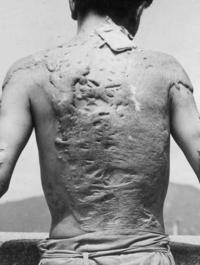 Left:Radiation burns on the back of Kiyoshi Kitsukawa, a Hiroshima tram conductor who was standing with his back to the blast about 1000 yards from the centre of the explosion.
Left:Radiation burns on the back of Kiyoshi Kitsukawa, a Hiroshima tram conductor who was standing with his back to the blast about 1000 yards from the centre of the explosion.
He was a small old man and he sat alone in the tram. It was late July and very warm and the tram was making its way through the southern suburbs of Hiroshima to the ferry terminal for the sacred island of Miyajima. The old man wore a large, floppy-brimmed canvas hat and a beige safari suit. He cradled in his lap a small bag. He had been watching me since I boarded near the A-Bomb Dome and sat on a bench opposite him.
As the tram emptied stop by stop along route two, he continued staring through his pair of enormous, thick-lensed spectacles. On occasion, I glanced at his kind, worn face and realized there was something not quite right with it - his features were curiously out of alignment. His left eye was smaller than his right, the difference exacerbated by the thick spectacle lenses. The cheekbone below the pinched eye was flat, in defiance of the other, which was round and full. It looked, to me, like a face that had suffered an accident a long time ago, and the imperfections were far away, on the horizon of a long life. At one point, it was just me and the old man in the tram, and this was when he rose slowly and sat beside me. "Where are you from?" he asked. His voice was thin and his English heavily accented but clear. "Australia," I said, turning to him.
He stared down at the carry bag in his hands. "Are you a soldier?" he asked.
I laughed at the unusual question. "No," I said.
"I remember the Australian soldiers in 1945," he said, "with the hats." He folded up one side of his canvas brim, making an impromptu slouch hat. "Very nice," he said, smiling.
Australian soldiers had taught him to speak English at a school in Hiroshima after the war. He had been born in 1928 and had been a "ship man" when he was younger. He gripped an imaginary ship's wheel with his old hands and motioned to steer from left to right. Then he said, unexpectedly: "I am of the atom bomb."
He rummaged in his carry bag and I noticed that the texture of the skin on his left hand was very smooth, an oddity consistent with his eye and his cheekbone. He was an old man divided into two sides. Eventually he produced a thick blue booklet the size of a passport. I had read of these books carried by A-bomb survivors. They were medical record books. "I am going to the hospital," he said, holding up the book. "Every week I go to the hospital." He tapped his knee with the book before returning it to his bag.
"I was visiting Hiroshima on that day," he said, recalling August 6, 1945. "The atom bomb. Wooosh." He raised a bunched fist and flicked his hand open to indicate the explosion. He looked at me with that crooked face and smiled again.
"I am of the atom bomb," he said.
I had come to Japan to retrace the steps of legendary Australian journalist Wilfred Burchett. As a young reporter, and in that early grappling for mentors and models, I had known of Burchett for a singular achievement - he was the first Western journalist into Hiroshima after the dropping of the atom bomb. In the 60 years since Burchett filed his report, "The Atomic Plague", for London's Daily Express, it has probably remained the greatest individual newspaper "scoop" of the 20th century and into the millennium. It's impossible to know now to what degree Burchett was writing for history, but you get the feeling, from the opening line, that the young Victorian reporter had an eye to posterity: "I write this as a warning to the world."
Burchett was almost 34 years old when he made his solo journey from Tokyo to Hiroshima to bring the facts of the bomb's devastation to the world, as he put it. At tremendous risk to his safety, he took the long train journey south, traveling in that delicate period between the dropping of the bombs on Hiroshima and Nagasaki and Japan's official surrender. It struck me, as a journalist and a novelist, that one day I would write a novel about this chapter in Burchett's life. The story had everything - war, flight, danger, heroism and, at the centre of it all, one of the defining moments in human history. I made some cursory notes.
Years later, I was browsing through a book stall at a Gold Coast flea market when I came across an extremely battered copy of one of the prolific Burchett's polemic books, This Monstrous War. The book dealt with the Korean conflict. By now I knew more about his life, his evolution into a "radical" journalist and his ability to polarize readers, colleagues, even governments. He was accused of being a communist spy, a traitor, a fabricator. His own country, for a time, refused to grant him a passport and re-entry into Australia. Since Hiroshima, his reputation had wobbled and stumbled.
I developed a theory, too, that the impact of what Burchett saw in Hiroshima, and the scoop itself, changed something inside him: that the dropping of the A-bomb was a schismatic moment for mankind, and also for Burchett's psychology. The theory had no basis in fact. It was the fancy of the novelist, trying to find a way into the head of an undeveloped character. I was already knitting a person called Burchett with the grand, subterranean themes of an unwritten novel. The A-bomb divided the 20th century. So, too, would atoms split in the mind of my Mr. Burchett, altering his view of the world, perhaps sending a hairline fracture through his soul.
When the Iraq conflict broke out in the wake of September 11, 2001, and the world witnessed the manipulation of the media by America, and truth, as they say, became a casualty itself, I kept thinking of Burchett and Hiroshima. In that instance, his purpose was the pursuit of truth. That purpose may have been tangled up with notions of future fame and accolades, of promotion and financial reward, of changing the world.
It is the dichotomy of reporting: at some points in your career you write for the public, but you also write for other journalists. "This is what I got," you're saying, "and you didn't." It was a dangerous, renegade act (often the prerequisite for defining moments) for which Burchett was later vilified by US government officials, who claimed he had fallen victim to Japanese propaganda. In some ways, it went to the very definition of reporting.
In the context of the contemporary world, with television and print journalists "embedded" with US troops invading Iraq (the word itself, embedded, so quickly redefined and attached to the media), I thought of Burchett and that warm September in 1945 when he walked through the ruins of Hiroshima with his notebook. I felt that something had been lost. That we had mislaid something very important about, or within, ourselves. That in modern times the media was like sediment, layer after layer of it, rolled out over feeling and empathy and rage and all those human responses to things that happen in the world. That everything would set like sandstone, and one day, beneath the many strata, a little fossilized truth would be found, embedded, fragile as a mosquito.
I'd bought Burchett's book This Monstrous War for $1, but didn't realize until I got home that it had been inscribed by the author. His best wishes and signature were scratched onto the title page in blue ink some time in the 1950s. When you begin a writing project you accept, beyond logic or reason, all manner of superstitions, totems, coincidences and signs. You believe they will help guide the arrow.
Go to Original
Surviving Hiroshima: Keiko Ogura
BBC News
Friday 05 August 2005
Keiko Ogura was eight years old when the atomic bomb was dropped on Hiroshima. She still lives in the city.
I wanted to go to school, but my father said 'I have a very strange feeling today - you shouldn't go to school, stay with us'.
That morning I was on the road near the house and all of a sudden I saw a flash of bluish white light - a magnesium-like flash and soon after a big sound with dust, and I was blown away and fell on the ground.
I found myself lying on the ground near the house. I thought the house was just in front of me but I couldn't see it because everything had become so dark and many pieces of wood and roof tiles and rubbish were falling on my head.
There was black rain falling... It smelled bad and there were many spots on my white blouse
And in the darkness there was a strong, strong wind like a typhoon. I couldn't open my eyes but tried to get back to my house and in the darkness I heard somebody was crying - my brother and sister.
I was 2.4km from the hypocenter but houses nearer the hypocenter had caught fire and were burning.
I saw long lines of refugees, just quiet, I don't know why they were so quiet. There were long lines, like ghosts.
Most of them were stretching out their arms because the skin was peeling off from the tips of their fingers. I could clearly see the hanging skin, peeling skin, and the wet red flesh and their hair was burned and smelled, the burnt hair smelled a lot.
And many people, just slowly passed by the front of my house.
Parched
All of a sudden a hand squeezed my ankle. I was so scared but they said 'get me water'. Almost all the people were just asking 'water', and 'help me'.
I rushed into my home where there was a well and brought them water. They thanked me but some of them were drinking water and vomiting blood and [then] died, stopped moving. They died in front of me. I felt regret and so scared. Maybe I killed them? Did I kill them?
And that night, 6 August, my father was so busy looking after the neighbors, but when he came back he said: 'Listen children - you shouldn't give water, some of the refugees died after drinking water. Please remember that.'
As a little girl I was so curious. I climbed up the hill, near our house... I was so astonished - all the city was flattened and demolished
Then I felt so guilty, and I saw them many times in my nightmares. I thought I was a very bad girl - I didn't do what my father said - so I kept it a secret. I didn't tell anybody this story until my father died.
There was black rain falling, black rain mingling with ashes and rubbish and oil, something like that. It smelled bad and there were many spots on my white blouse - sticky, dirty rain.
In the morning people were moving, brushing away flies from their skin. My house was full of injured people.
But as a little girl I was so curious. I wanted to see what the city looked like. My house was at the bottom of a hill - I climbed up the hill, near our house, and then I saw the whole city. I was so astonished - all the city was flattened and demolished. I counted just a couple of concrete buildings.
In Denial
The next day some of the buildings were still burning, and the next day, and the next day, and for three or four days I climbed the hill to see what the city was like.
I have a brother-in-law. He was living almost at the centre of the city - his family was very close to the hypocenter. Until now his family members were missing and he didn't want to recognize they were all gone, so he refused to say and report the family's names to the officials and he didn't want to visit Hiroshima.
Right now, he is living far away in Tokyo, and only last year he decided to report to Hiroshima city that his family members - his mother and sister - had passed away.
And there were so many people [who saw] so many dead or dying, but actually, most of them made up their mind not to tell anyone about what they saw.
This interview is from the series 'August 1945', from 3-14 August on BBC Radio 4, at 8.55 BST Mondays-Saturday, and at 9.55 BST on Sunday.
(In accordance with Title 17 U.S.C. Section 107, this material is distributed without profit to those who have expressed a prior interest in receiving the included information for research and educational purposes. t r u t h o u t has no affiliation whatsoever with the originator of this article nor is t r u t h o u t endorsed or sponsored by the originator.)
"Go to Original" links are provided as a convenience to our readers and allow for verification of authenticity. However, as originating pages are often updated by their originating host sites, the versions posted on TO may not match the versions our readers view when clicking the "Go to Original" links.
Posted by
Anna Haight
at
3:07 PM
0
comments
![]()
Friday, August 05, 2005
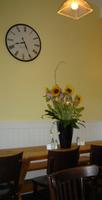
 Cafe Z. Well, well! Another find not found on the Internet. I took my own photos! Dad and I celebrated the end of his treatment this morning at this charming crepe and sandwich place which serves an awesome breakfast. Talking with the woman who took our $ and made our hot chocolate and mocha drinks, it's been around for about a year.
Cafe Z. Well, well! Another find not found on the Internet. I took my own photos! Dad and I celebrated the end of his treatment this morning at this charming crepe and sandwich place which serves an awesome breakfast. Talking with the woman who took our $ and made our hot chocolate and mocha drinks, it's been around for about a year.
I noticed on the table that it serves supper now too, and Sally Sampson created the recipes. Good going Sally!
Cafe Z is in Greenbrae's Bon Air Shopping Center between Fifi's Diner and Peet's Coffee.
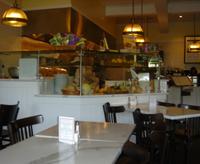
Here's a shot of the interior. Very inviting. Dad had a crepe filled with eggs, and I their carmelized onion and mozzarella scramble. Will definitely revisit.
Make someday today!
 Of course, we had to end the last day with a dinner celebration too. Asked Dad what kind of food he'd like, where he'd like to go, he responded 'anywhere' 'you choose'.. so I just started driving. Ended up in San Anselmo, and noticed Insalata's -- one of those places that I passed frequently and thought 'someday I'll try it'.. well I stopped quickly and made 'someday' 'today'. Good idea. That was a really marvelous place! What inventive Mediterranean food. My fresh halibut was on a bed of Israeli couscous. I've never had Israeli couscous outside my home or Israel previous to this evening. Seems its an up and coming thing. The Fattoush Salad is totally inspiring. I'm so afraid of this one getting away, I'm going to replicate it below...
Of course, we had to end the last day with a dinner celebration too. Asked Dad what kind of food he'd like, where he'd like to go, he responded 'anywhere' 'you choose'.. so I just started driving. Ended up in San Anselmo, and noticed Insalata's -- one of those places that I passed frequently and thought 'someday I'll try it'.. well I stopped quickly and made 'someday' 'today'. Good idea. That was a really marvelous place! What inventive Mediterranean food. My fresh halibut was on a bed of Israeli couscous. I've never had Israeli couscous outside my home or Israel previous to this evening. Seems its an up and coming thing. The Fattoush Salad is totally inspiring. I'm so afraid of this one getting away, I'm going to replicate it below...
********************************
Syrian Fattoush Salad
As a fattoush maker for over 15 years, I know this salad like the back of my hand so I have some very helpful tips:
- Use only the hearts of the romaine--don't be tempted to use the tough outer leaves. Also, tear off the top of the heart if it seems limp and leathery.
- Traditionally, Italian parsley is used in place of cilantro, but I like the flavor balance of the mint and the cilantro. The size of a bunch of cilantro or mint in the summer months is double the size than in the winter. So, if you have big bunches in the summer, use 1/4 of a bunch, instead of 1/2 of a bunch.
- Splurge on French sheep's feta or a good quality imported feta cheese. It's rich with a nice salt and acidity balance. Don't skimp!
- Use fresh lemon juice, cumin seed and real Kalamata olives. Remember that the taste of the lemon juice varies through the year so use your buds and adjust accordingly. Adding a pinch of sumac to boost up the flavors of the lemons is one trick.
- Use fresh cumin seed, and not the pre-ground powder. There is a big difference in flavor when you toast the seeds to coax out their oils.
- And finally, don't buy canned, pitted olives. Take the extra time to pit real Kalamatas yourself. I promise that you'll be happy with the results!
Salad:
3/4 cup vine-ripened cherry tomatoes, halved
3/4 cup English cucumber, peeled, seeded and diced in 1/4 inch cubes
1/4 cup thinly sliced red onions (about 1/2 of a small red onion)
1/4 cup finely chopped cilantro (about 1/2 a bunch)
1/4 cup finely chopped mint (about 1/2 a bunch)
6 cups hearts of romaine lettuce (about 3 hearts), torn roughly by hand
2 pieces of pita bread
2/3 cup sheep's milk feta cheese
1/4 cup pitted Kalamata olives (about 12 olives)
Lemon vinaigrette:
1 teaspoon finely chopped garlic (about 1-2 cloves)
1/4 cup freshly squeezed lemon juice
1 tablespoon rice wine vinegar
3/4 teaspoon toasted and freshly ground cumin (see below)
2 ounces olive oil
5 ounces extra virgin olive oil
Salt and freshly ground black pepper
Serves 6 as a side dish
To make the pita chips, preheat oven to 350˚. Trim edges off of the pita, keeping a circle shape, so that the pita can be split into two halves. Cut each half into 6 triangles and arrange on a baking sheet. Toast for approximately 12 minutes, or until the pita chips crisp up and are golden brown. Turn baking sheet halfway through baking. Set aside and cool. Break the chips into large pieces.
To make the vinaigrette, in a small saucepan over medium-heat, toast cumin until aromatic and light brown, approximately 3 minutes. Toss occasionally to prevent burning. Let cool and set aside. Grind in a spice grinder until cumin becomes almost like powder. In a medium bowl, whisk together the garlic, lemon juice, rice wine vinegar, cumin, extra virgin olive oil and olive oil. Season to taste with generous amount of salt and black pepper. Set aside.
To serve, toss romaine hearts, cherry tomatoes, feta cheese, mint, cilantro, red onions and olives with the vinaigrette in a large bowl, making sure that the leaves are well coated with the vinaigrette. Divide the salad among 6 chilled salad plates. Serve immediately.
Sidebar:
Sheep are the most important dairy animal in the Mediterranean. In much of the Middle East, the sheep's milk cheese of choice is feta. Look for imported sheep's milk feta cheese which has been barrel aged. To feta aficionados, there is no comparison between artisnal-barrel aged feta and the feta produced in huge automated factories. However, given the expense and in some areas the unavailability of barrel-aged feta, feta cheese imported from Greece, France and Bulgaria are your next best bet.
Posted by
Anna Haight
at
10:10 PM
0
comments
![]()
Thursday, August 04, 2005
 Cafe Marmalade. This cafe advertising 'freshly baked' in Ross, looks cute, but fails to stand up. A big part of their menu for breakfast were bagel creations, but they had no bagels. So we chose sweets and cafe mocha. The cafe mocha was served in chipped cups, and the place looked a little unkempt, including the garden which could be charming with a little attention. Music was piped into the garden, French songs at first, changing to Indian, which didn't match the mood of the garden although I liked the tunes.
Cafe Marmalade. This cafe advertising 'freshly baked' in Ross, looks cute, but fails to stand up. A big part of their menu for breakfast were bagel creations, but they had no bagels. So we chose sweets and cafe mocha. The cafe mocha was served in chipped cups, and the place looked a little unkempt, including the garden which could be charming with a little attention. Music was piped into the garden, French songs at first, changing to Indian, which didn't match the mood of the garden although I liked the tunes.
The town of Ross is charming and well worth a stroll through the tree lined commons. It looks like a charming small town, locked in a past time, but kept that way intentionally and artistically.
Posted by
Anna Haight
at
10:42 PM
0
comments
![]()
Labels: Ross
Wednesday, August 03, 2005
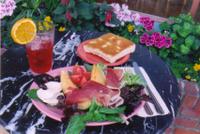 Caffe DiVino. This is a two-day post because basically, we were homebodies the last two days... going to UCSF in the morning for Dad's treatment and then lounging at home. Well, I did work from home too which left less 'play' time, but I don't want to exhaust ALL my vacation time.
Caffe DiVino. This is a two-day post because basically, we were homebodies the last two days... going to UCSF in the morning for Dad's treatment and then lounging at home. Well, I did work from home too which left less 'play' time, but I don't want to exhaust ALL my vacation time.
This morning we attempted to visit the Winship, but contrary to its advertised open times during the week for breakfast, it was most definitely closed. So we went to a most charming Italian caffe on Caledonia Street, Caffe DiVino. The owner is very much in sight and took our orders for the unique Italian omelets. Very good, and creative, pleasant interior with original art work on the walls and multi-colored wood inlaid tables.
Posted by
Anna Haight
at
10:09 PM
0
comments
![]()
Labels: Marin Breakfasts, Sausalito
Monday, August 01, 2005
 Ramp Bulbs or "Wild Leeks". Had to pick up some of these at the Ferry Building when I saw them at Far West Fungi. I made Dad lunch of a pizza with whole-wheat crust, some of these wild leeks, heirloom tomatoes, porcini mushrooms, Canadian bacon, and organic mozzarella cheese.
Ramp Bulbs or "Wild Leeks". Had to pick up some of these at the Ferry Building when I saw them at Far West Fungi. I made Dad lunch of a pizza with whole-wheat crust, some of these wild leeks, heirloom tomatoes, porcini mushrooms, Canadian bacon, and organic mozzarella cheese.
He was feeling so perky, we went late afternoon to visit the Winchester Mystery House in San Jose, which was surprisingly just across the street from Santana Row, so we window shopped and had dinner at Maggiano's Little Italy. A very nice celebration for the 'real' last day of chemo!
Posted by
Anna Haight
at
10:17 PM
0
comments
![]()
